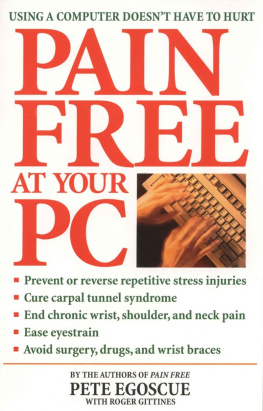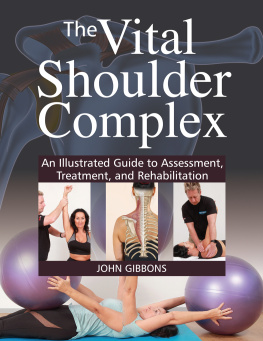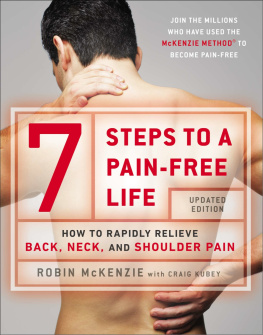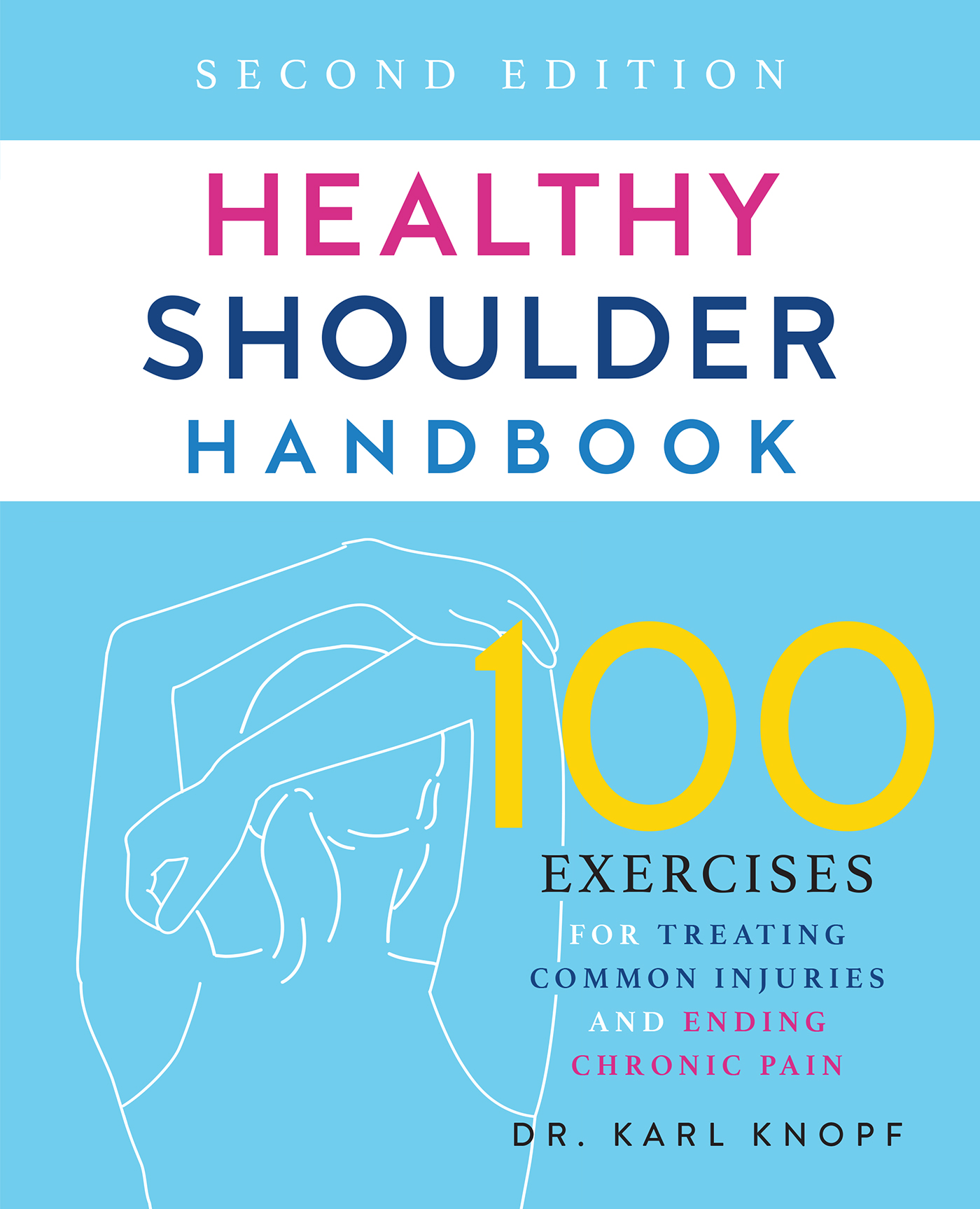Contents
Guide
Second Edition
Healthy Shoulder Handbook
100 Exercises for Treating Common Injuries and Ending Chronic Pain
Dr. Karl Knopf
Text copyright 2010, 2021 Karl Knopf. Design and concept copyright 2021 Ulysses Press and its licensors. Photographs copyright 2010, 2021 Rapt Productions except as noted below. All rights reserved. Any unauthorized duplication in whole or in part or dissemination of this edition by any means (including but not limited to photocopying, electronic devices, digital versions, and the internet) will be prosecuted to the fullest extent of the law.
Published in the US by: Ulysses Press
PO Box 3440
Berkeley, CA 94703
www.ulyssespress.com
ISBN: 978-1-64604-196-1
ISBN-13: 978-1-6460-4226-5 (eBook)
Library of Congress Control Number: 2021931498
Contributing writer: Fiona Gilbert
Acquisitions: Claire Seilaff
Managing editor: Claire Chun
Editor: Renee Rutledge
Proofreader: Barbara Schultz
Index: Sayre Van Young
Front cover design: Rebecca Lown
Interior design: what!design @ whatweb.com
Artwork: cover illustration ; photographs Rapt Productions
Production: Jake Flaherty
Models: Samuel Harvell, Scott Mathison, Meredith Miller, Bernadett Otterbein, Toni Silver
PLEASE NOTE: This book has been written and published strictly for informational purposes, and in no way should be used as a substitute for consultation with health care professionals. You should not consider educational material herein to be the practice of medicine or to replace consultation with a physician or other medical practitioner. The author and publisher are providing you with information in this work so that you can have the knowledge and can choose, at your own risk, to act on that knowledge. The author and publisher also urge all readers to be aware of their health status and to consult health care professionals before beginning any health program.
INTRODUCTION
This book provides an overview of shoulder anatomy, as well as common causes of injuries to better understand prevention. The goal of this book is to acquaint you with possible shoulder conditions and offer suggestions for prevention and corrective exercise options. Many physical therapy textbooks and journals were reviewed to make sure the information contained within is credible and has scientific background. However, this is by no means a substitute for medical care. The hope of this book is for you to learn to TRAIN SMART, NOT HARD, because learning to listen to your body and heed what it says is the wisest thing you can do. Identifying a small shoulder issue and engaging in active rest along with performing corrective exercise can go a long way in keeping you in the game.
With the supervision of a doctor, anyone can use this book to strengthen an injured shoulder or identify the onset of a shoulder problem.
The shoulder joint is complex, remarkable, and subject to injury. Shoulder dysfunction is caused by many variables: falls, overuse, misuse, and even disuse after an injury. Shoulder mobility can also be impaired after cancer treatments. Injury to the soft tissue surrounding the shoulder joint may very well be prevented if you engage in a proactive, progressive strengthening and stretching program of corrective exercises.
Often the onset of a shoulder problem manifests slowly over time and if neglected, it impairs function or causes excessive pain. Shoulder pain is reported to occur in 20 percent of the adult population. Too often, people hurt or strain their shoulder and dismiss the injury, only to allow it to exacerbate to a significant issue. The current belief is getting therapy and treatment early can prevent major problems in the future. Being proactive about the care of your shoulder as a preventive method now, before something big happens, is the best idea.
The good news is most people with shoulder pain can both improve function and reduce pain through physical therapy and corrective exercise. According to the Journal of Orthopaedic & Sports Physical Therapy, shoulder exercises are an excellent way to manage pain and improve function.
WHO GETS SHOULDER ISSUES?
Statistics show that a significant number of the adult population has or will suffer from a shoulder joint dysfunction that affects daily activities. A shoulder dysfunction is no small problem; it can disable you for a sustained period of time.

Author Karl Knopf makes some adjustments.
Other than trauma and repetitive chronic misuses, often postural deviations or muscle imbalances can contribute to shoulder issues. If one set of muscles gets too tight, the delicate balance of the space in the shoulder complex is upset, possibly throwing the alignment out of place. This is similar to the guide wires of a radio tower; if theyre too tight, they can cause misalignment. These misalignments set the stage for injury. With proper joint alignment, you can expect an ideal range of motion. (Perhaps if we follow Joseph Pilatess advice of strengthening what is weak and stretching what is tight, some of our shoulder issues will never occur.)
According to the American Academy of Orthopedic Surgeons, shoulder dysfunction is caused by many situations, including falls and overuse from work or play. Today we even see children complaining of shoulder and neck pain caused by poor posture, poor biomechanics while playing computer games, back and shoulder strain from carrying heavy backpacks, or overzealous coaches pushing them beyond their physical limits.
The most common causes of shoulder issues include:
- Age
- Falls
- Improper body mechanics
- Repetitive or prolonged overhead movements
- Prolonged use of machinery that causes jarring/vibration of shoulder joint
DO I HAVE A SHOULDER ISSUE?
Unfortunately, many people wait too long before going to the doctor about their shoulder problem, assuming it will just get better on its own. Research suggests that most people dont go to the doctor until theyve lost some level of range of motion or the pain is unbearable. Proactive steps such as medical care and gentle movement are the keys to recovering from shoulder issues.
Ironically, the natural response to stop using the shoulder when it hurts may actually contribute to a condition called frozen shoulder.
If you suspect that you have a shoulder issue, get a diagnosis ASAP. An early intervention can keep a small issue from becoming a big one. Make an appointment with your primary care doctor, whos usually the port of entry into the medical system. Your primary care doctor may then refer you to other health professionals.
If you have pain or difficulty with any of the following, its a sign that you may have a shoulder problem and should seek medical advice.
- Putting on a coat
- Sleeping on your side
- Reaching behind you, as when grabbing something in the backseat of the car from the drivers seat)
- Reaching up your back, as when zipping up a back zipper









